
His new fridge uses 75% less kilowatts per month which cuts down its fuel bill to about $4.00.

The new washing machine uses much less water per load. Their monthly water usage total is about 440 gallons, or 40% of the average household.

They did a beautiful job tiling the shower, so I had to take a shot of it.

This is their composting toilet. The gasmask is a joke. It has a fan in the tank below which pulls the air out of the bathroom.

This is the waste pipe for the toilet upstairs.
 The salvaged the beautiful oak floors from a schoolhouse slated for demolition.
The salvaged the beautiful oak floors from a schoolhouse slated for demolition.
 This stove heats the place with downed wood they collect. The house is so well insulated it doesn't take much to get warm. "Pancho" (a plastic Einstein doll) rides atop the cowboy hat.
This stove heats the place with downed wood they collect. The house is so well insulated it doesn't take much to get warm. "Pancho" (a plastic Einstein doll) rides atop the cowboy hat.
 They learned how to set tile on their screened in back porch. We got to meet Hemingway, who is a very friendly 5 month old.
They learned how to set tile on their screened in back porch. We got to meet Hemingway, who is a very friendly 5 month old.
We went out the back door for a look at the graywater system.
 It comes out these pipes...
It comes out these pipes...
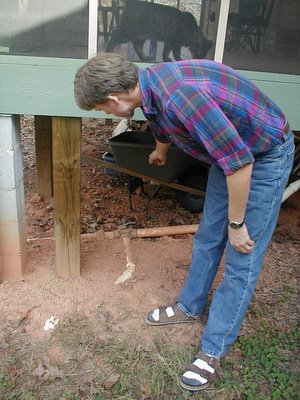 and gets sent to one of the two fields via this valve, which he switches every couple of weeks to let the mulch dry out...
and gets sent to one of the two fields via this valve, which he switches every couple of weeks to let the mulch dry out...
 and it comes out of this pipe into the drainage cachement which sends the water to nourish a fruit tree.
and it comes out of this pipe into the drainage cachement which sends the water to nourish a fruit tree.
Now its time for a trip to the basement to see the inner workings of the house.
 It was built with this insulating material, made of Styrofoam sandwiched between OSB. The ones in the outside walls are about 4" thick and have an R factor of 17. The ones on the roof are thicker.
It was built with this insulating material, made of Styrofoam sandwiched between OSB. The ones in the outside walls are about 4" thick and have an R factor of 17. The ones on the roof are thicker.
An airtight house means a ventilation system is needed. When people ask if they will get sick from a well sealed home, Allison responds that a home can't be too tight, just underventilated.
 This one exchanges heat between the air going in and going out. The next step up exchanges humidity as well.
This one exchanges heat between the air going in and going out. The next step up exchanges humidity as well.
 This pipe evacuates the radon from underground. Its easy to install if you do it when pouring the slab. The negative air pressure draws radon gas up and out the vent in the roof.
This pipe evacuates the radon from underground. Its easy to install if you do it when pouring the slab. The negative air pressure draws radon gas up and out the vent in the roof.
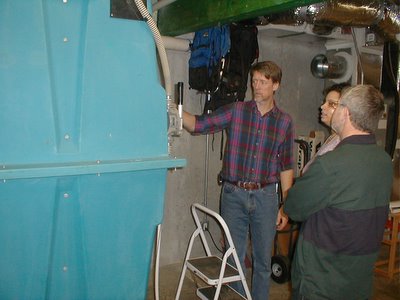 This is the tank of the composting toilet.
This is the tank of the composting toilet.
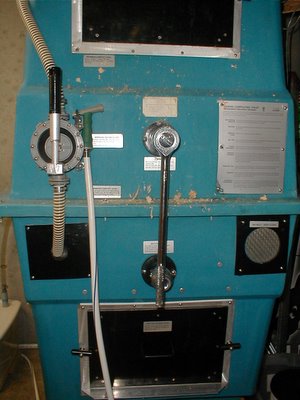 The sawdust gets stirred by tines attached to the top axel. The compost comes out of the bottom panel.
The sawdust gets stirred by tines attached to the top axel. The compost comes out of the bottom panel.
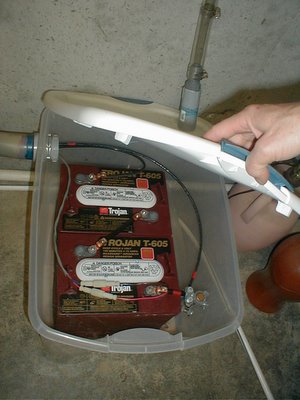 The fan and the light (to attract and kill mold gnats) is on a 12 volt system.
The fan and the light (to attract and kill mold gnats) is on a 12 volt system.
 The water pump is also powered by these batteries.
The water pump is also powered by these batteries.
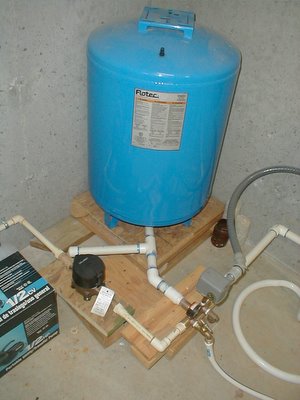 The water is pressurized in this tank.
The water is pressurized in this tank.
Now its time to tour the grounds.
 The greenhouse.
The greenhouse.
 A tractor from the 1940s that they got running with a little TLC and a lot of moola.
A tractor from the 1940s that they got running with a little TLC and a lot of moola.
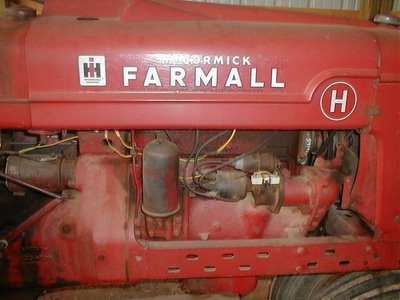 My hubby used to ride on one of these growing up on the farm.
My hubby used to ride on one of these growing up on the farm.
 Next year this area will have chickens and maybe goats. The mound is their compost pile.
Next year this area will have chickens and maybe goats. The mound is their compost pile.
 The garden/field is fenced off to protect it from the deer. Apple scented modules lure them and then shocks their noses. They learn to stay away instead of figuring out that they can jump the fence.
The garden/field is fenced off to protect it from the deer. Apple scented modules lure them and then shocks their noses. They learn to stay away instead of figuring out that they can jump the fence.
 The well is 302 feet deep.
The well is 302 feet deep.
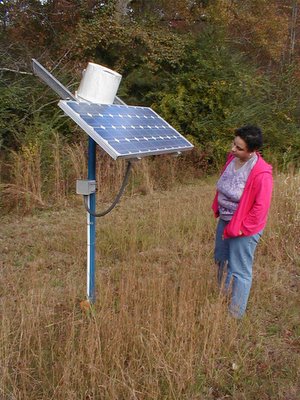 The pump is powered by this solar panel.
The pump is powered by this solar panel.
 We learned a lot and had a great time hanging out. Thanks for your hospitality, Allison, and thanks for coming everyone!
We learned a lot and had a great time hanging out. Thanks for your hospitality, Allison, and thanks for coming everyone!
No comments:
Post a Comment